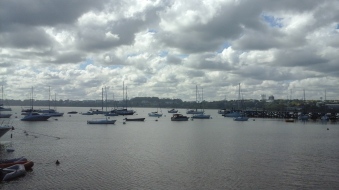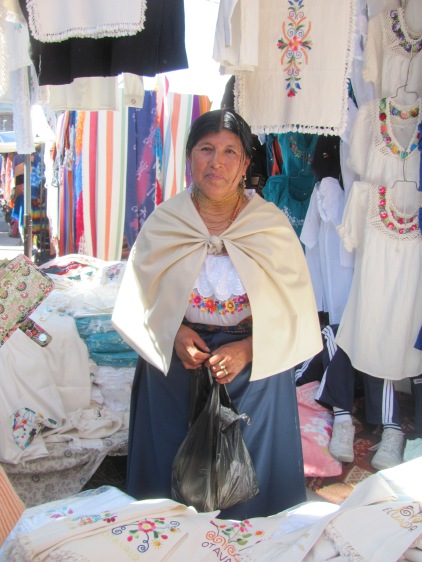Heaving a sigh of relief that we were finally settled aboard our ferry to Colonia del Sacramento, I was surprised to pick up on a familiar scent. Was that the ocean I smelled…but hold on…what ocean? It suddenly occurred to me that the ferry from Buenos Aires (BA) which was taking Hubby and me across the bay of the Rio de la Plata to Colonia del Sacramento in Uruguay was crossing a huge expanse of water that empties directly into the Atlantic Ocean. Looks are deceiving when you are confined to a large metropolis like BA. You really are totally unaware of any ocean nearby. Their harbour front looks more like a river. I must confess the ocean smell brought on a wee bit of homesickness. After all, I had not been anywhere near an ocean since leaving my Nova Scotian home almost four months ago.
It was our last week in Buenos Aires in April this past winter that Hubby and I decided to take a quick trip over to Uruguay, the tiny country to the northeast of Argentina. It’s an easy trip from BA over to Colonia del Sacramento, Uruguay’s second largest city after Montevideo, its capital. No visa is required and Uruguay’s peso is almost par to the Argentinian peso. Either one is accepted so we used our Argentinian pesos to avoid the hassle of changing any money. Travelling there is easy with two separate ferry companies vying for passengers : the Bourque Bus and the Colonia Express. We took the latter since it was a bit cheaper and used more by the Argentinians. Bourque seemed to cater more to the tourists who want to visit for the day only and get there fast…in about an hour! This option can be more expensive but not necessarily any better. Our crossing took three hours which was fine with us since we weren’t in a great hurry. We were planning to spend the night there and return the next day.
By the time our ferry reached our destination, the fog, which had delayed our crossing by more than an hour, had lifted, allowing the sun to burst forth and present us with a brilliant autumn day. Colonia del Sacramento has a population of roughly 27,000 and is a UNESCO World Heritage site. With its cobblestone streets lined with stately sycamore trees, it’s a fantastic city for walking just about everywhere. We found our small, family owned hotel – the Los Pinos – with an easy 15 minute walk from the ferry terminal. The centre of the city showcasing museums, restaurants, shops, and the harbour were another easy 15 minute walk from there so a taxi was not needed.
Colonia del Sacramento is one of South America’s most authentic Spanish/Portuguese settlements founded in 1680 by the Portuguese. It passed back and forth in a tug-of-war between Portugal and Spain until 1809 when Uruguay finally achieved its independence from Spain. Over the years it has managed to preserve its heritage so that today you can see some remains of the wall and fortress that once protected it from invaders. Many of the buildings dating back to that time have been lovingly maintained or restored.
As soon as we got settled into our hotel, we went in search of a cafe hoping to find one with good coffee. As we turned the corner from our street onto the main street…Av General Flores… lo and behold, there was before us a few small tables placed carefully on the sidewalk. And, there to our left was what looked like a coffee shop! This looked good and so did those mouth-watering cupcakes! The chap running the whole show turned out to be the owner who spoke excellent English and ended up serving us one of the best lattes yet. It was still too early in the day for one of those cupcakes; however, we did go back the following day for that indulgence and didn’t regret it. Colonia Sandwich and Coffee Cafe is owned and run by a young couple from Uruguay who learned the art of good coffee-making while living in Italy.
After our coffee fix, we were now ready to explore the Cuidad Vieja or old city. The best place to begin a tour in any South American city or town is the main square or Plato Mayo. There is always at least one church to admire, if not on the inside, then at least from the outside. My favourite pastime is to spend some time sitting in a park people watching. However with so much more of the city to see, we were compelled to finally tear ourselves away from the park and an interesting conversation with a friendly fellow who had just moved to Uruguay from Toronto.
We continued on and soon found ourselves at the harbour. Before us lay a lovely nautical setting which for me was another reminder of Nova Scotia. We walked along the pier to the lighthouse at the end admiring the display of vessels in all shapes and sizes. This could easily have been Chester, our famous resort town in Nova Scotia. The seaside restaurants looked so inviting that we decided to take another break and treat ourselves to a Campari special accompanied by delicious croquettes at a restaurant with an outdoor deck. Yes, somewhat decadent for that time of day, but the drink and the warmth of the sun pouring down upon us… remember we were in autumn and hadn’t seen much of the sun for two weeks…gave us another memorable experience to store away from this visit.
Sufficiently fortified with food and drink, we once more set out for the Cuidad Vieja…but not before first checking out another lighthouse in the midst of the ruins of the San Francisco Convent built in 1694. A small entrance fee allowed me to climb to the top of the lighthouse where I got a fantastic view of the harbour and the entire city. Since Hubby doesn’t do well with heights, he decided to wait out this adventure.
An hour or so later, we finally arrived at the City Gate and the entrance to the Cuidad Vieja. Although the Gate and the wall surrounding the old city were probably first built some time in the late 1600’s to keep marauding invaders at bay, much of it was rebuilt in 1968. By the time we had wandered down the ‘Street of Sighs’, one of the original cobblestone streets constructed by the Portuguese which has the drain running down the middle of it, we noticed that the sun had disappeared and dark clouds were already beginning to take over.
Unfortunately, the threat of the rain which quickly morphed into a down pour soon put an end to our site seeing for the day.
The next morning it was still raining heavily putting a bit of a damper…no pun intended… on what we could do. After a substantial breakfast at our hotel and another delicious coffee at the Sandwich and Coffee Cafe we decided to seek out the only option we had …. to spend our remaining time in the museums. Colonia del Sacramento boasts of having at least eight of them but because of the rain we could find only two open for business. One was the Municipal Museum so we sought refuge there. This one portrayed the history of the city as well as a good commentary on the culture and social customs of the 18th century. Running between the showers, we found the Portuguese Museum was open, too, so sought further shelter there along with some other tourists doing the same as us. Here we found a home from the same time period which reflected how the first Portuguese settlers lived their daily lives. I was struck by the similarity of their life to that of our Acadians…simple but functional.
Since our ferry wasn’t leaving until later that afternoon, our only option to keep us from getting a thorough soaking was to find a good eating place. Our hostess at Los Pinos had highly recommended Jon Joaquin, a well established restaurant with the best Neapolitan pizza outside of Italy, but after a somewhat wet search, we arrived only to find it closed. Desperate to get out of the rain, we headed back to Av General Flores and decided to take our chances by eating at the busiest restaurant we could find. If it’s busy and full of locals it must be good … or so the reasoning goes and is usually true. We decided on one very close to our coffee place and our hotel. Hubby had his proverbial beef with beer which satisfied him, however, my choice was a mistake. Not understanding the menu or our waiter, I thought I was ordering a Uruguayan speciality. Perhaps this dish was special to Uruguayans, but I have to admit I wasn’t impressed with the foot long wiener I found on my plate. The oversized salad accompanying it looked good but the scarcity of dressing was disappointing. Apparently dressings, sauces and spices are often used sparingly, if at all, not only in Argentina but in Uruguay as well.
For anyone who decides to visit Colonia del Sacramento, there are probably many choices for good restaurant eating judging by the recommendations in Lonely Planet and Trip Advisor. One of them is the El Drugstore where we ate the night before. The food was good and wholesome, but what pleased us most about this place was the funky decor, the friendly service, and the entertainment. We were serenaded by a beautiful young woman with a fantastic voice and had the pleasure of her company during intermission. She once lived in London where she starred in musicals and built up quite a reputation for herself until she was lured back to her family and country. This seems to be a pattern for Uruguayans as well as Argentinians… to work and live abroad in Europe only to eventually return home to use what they have learned for benefit to their own country.
If you were to ask me if our trip to Uruguay was worth it, I would have to say ‘yes’. Although a small country not much different in culture and history from its big neighbour to the south, it is still somehow different. I think it was the people we met in the short time we were there who were a little more open and willing to talk. They also appeared to be happier … but then who wouldn’t be in such a desirable city …with its history, culture, and location by the sea. It has much to boast about and those we met seemed more than willing to share positive thoughts on their country. If Colonia del Sacramento is a reflection of the rest of Uruguay, which I believe it is based on what I’ve read and heard, then it’s a wonderful example of how some South American countries are safe, politically stable, and experiencing a high standard of living. If you would like to learn more about Uruguay and its capital, Montevideo, you could check out http://traveleater.wordpress.com, a blog by Johanna Reid, who also visited Uruguay this past winter.
To view the gallery of photos below, click on the first picture and go from there. I hope these can help you enjoy Colonia del Sacramento as much as I did.

Arriving at the Los Pinos Hotel.

Avenue General Flores near our hotel.

A sycamore lined street.

The Colonia Sandwich & Coffee Cafe.

Colonial architecture.

The Plato Mayo.

The Plato Mayo

Enjoying the park.

The harbour

Enjoying our campari special.

Lighthouse in the ruins of the San Francisco Convent.

View from the top of the lighthouse.

At the City Gate.

Remnants of the old wall.

Old cars are a common sight.

Outside El Drugstore where we had dinner.











































































